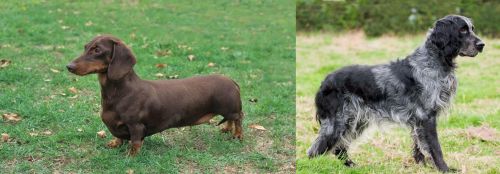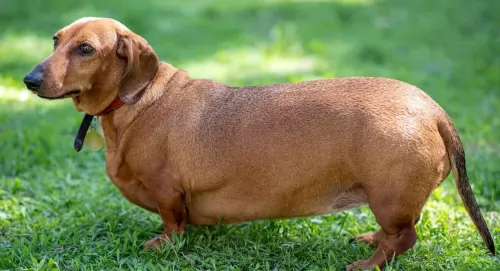 MyDogBreeds
MyDogBreeds Dachshund is originated from Germany but Blue Picardy Spaniel is originated from France. Dachshund may grow 33 cm / 12 inches shorter than Blue Picardy Spaniel. Both Dachshund and Blue Picardy Spaniel are having almost same weight. Both Dachshund and Blue Picardy Spaniel has almost same life span. Both Dachshund and Blue Picardy Spaniel has same litter size. Dachshund requires Low maintenance. But Blue Picardy Spaniel requires Moderate maintenance
Dachshund is originated from Germany but Blue Picardy Spaniel is originated from France. Dachshund may grow 33 cm / 12 inches shorter than Blue Picardy Spaniel. Both Dachshund and Blue Picardy Spaniel are having almost same weight. Both Dachshund and Blue Picardy Spaniel has almost same life span. Both Dachshund and Blue Picardy Spaniel has same litter size. Dachshund requires Low maintenance. But Blue Picardy Spaniel requires Moderate maintenance
 The Dachshund originated in Germany. He was used as a hunting dog with his origins starting way back in the 15th century already. The small dog was developed to hunt for animals that buried themselves deep underground such as badgers. The shape of the dog and his courage and bravery allowed him to take on the badger.
The Dachshund originated in Germany. He was used as a hunting dog with his origins starting way back in the 15th century already. The small dog was developed to hunt for animals that buried themselves deep underground such as badgers. The shape of the dog and his courage and bravery allowed him to take on the badger.
There has been a lot of debate as to whether the Dachshund is a hound or terrier, and it was decided that the Dachshund is a hound that became a terrier, and which displays some of the best qualities of both.
It was in 1881 that the Dachshund Club of England was formed and the German Deutscher Teckelklub was formed in 1888. The small dog gained popularity in America and the Dachshund Club of America was founded in 1895.
 The Blue Picardy Spaniel is a direct descendent of the French spaniel. It was in the 14th century that recorded descriptions of the French ‘setting dogs’ emerged but it is believed that the spaniel originated before that.
The Blue Picardy Spaniel is a direct descendent of the French spaniel. It was in the 14th century that recorded descriptions of the French ‘setting dogs’ emerged but it is believed that the spaniel originated before that.
The spaniels separated into different regional types where size and colour varied according to the region they were in. It was developed in the northern part of France and bred with Gordon- and English Setters, resulting in a Belton blue color, which is a type of blue ticking coloration. The dog was recognized as a separate breed in France in 1938.
 Known as Badger Dogs, Sausage Dogs or Doxies, the Dachshund is known for his long body, his sharp, pointed face and the short legs with the large front paws.
Known as Badger Dogs, Sausage Dogs or Doxies, the Dachshund is known for his long body, his sharp, pointed face and the short legs with the large front paws.
He stands at about 21-28 cm while the female may be 20-25 cm and weighing 6 to 15kg. He is the smallest of the hound dogs, with the standard size dachshund being developed to scent and chase badgers and other animals.
There are different Dachshund coat varieties – the smooth coat, the long-haired Dachshund and the wire-haired dachshund. They also come in a number of solid colors such as brown, red, tan, chocolate and black.
The dachshund is an energetic,social little dog with a loving personality. He’ll love to lie as close as possible to you on the couch and be with you wherever you are. Training and socialization is important so he doesn’t become too protective so that he wants to go for anyone who comes near.
He can be stubborn but he is also protective of his human family. Dachshunds are known for their tendency to bark but training and socialization can help tremendously to make him obedient and relaxed around humans and pets.
He is small enough to be a great pet in the city or in the country. He loves to spend time indoors- as well as outdoors. He can become a loving companion and gets on well with children and pets in the house. In spite of his small size, he makes a good watchdog.
 The medium-sized, well muscled Blue Picardy Spaniel has such an amicable expression on his face with such gentle brown eyes that it is difficult to think of him as a gun dog. He is often described as a quiet dog, but lots of fun. He has long legs and stands about 56–61 cm high at the withers, weighing about 19–20 kg. His speckled grey-blue coat with black patches is medium length and wavy and you’ll find typical Setter feathering on the legs, the tail and underside. The medium-length, drooping ears are also covered in silky, feathery hair, a blue/grey coat with black patches and has long feathering on the belly, legs, ears and tail. When the puppies are born they’re white with black patches, but this changes as they mature.
The medium-sized, well muscled Blue Picardy Spaniel has such an amicable expression on his face with such gentle brown eyes that it is difficult to think of him as a gun dog. He is often described as a quiet dog, but lots of fun. He has long legs and stands about 56–61 cm high at the withers, weighing about 19–20 kg. His speckled grey-blue coat with black patches is medium length and wavy and you’ll find typical Setter feathering on the legs, the tail and underside. The medium-length, drooping ears are also covered in silky, feathery hair, a blue/grey coat with black patches and has long feathering on the belly, legs, ears and tail. When the puppies are born they’re white with black patches, but this changes as they mature.
The Blue Picardy Spaniel is a loyal and devoted companion, who just loves to spend time with his human family. He loves to work hard and play hard and he makes a splendid family pet. He’ll also get along well with other pets. Treat him with love and care and you’ll find that the Blue Picardy Spaniel is an even-tempered pet who wants to please. Being alert, he will bark to warn you of strangers.
 The Dachshund may be small but he is courageous, brave and loyal. He gets on well with children and pets in the home but care needs to be taken because of his long back.These dogs are prone to disk problems so you have to be careful with rough and tumble from children.
The Dachshund may be small but he is courageous, brave and loyal. He gets on well with children and pets in the home but care needs to be taken because of his long back.These dogs are prone to disk problems so you have to be careful with rough and tumble from children.
Dog experts say that the different kinds of Dachshunds produce different personalities and that the longer-coated one is more amicable than the short-coat variety. Whichever variety you choose, they are guaranteed to entertain and delight you and be a loyal, loving companion.
 The Blue Picardy Spaniel is a gentle, intelligent breed and he responds well to training. He is such an easy going dog who wants to please his owners. They also do well with children and other pets, making him a wonderful family pet.
The Blue Picardy Spaniel is a gentle, intelligent breed and he responds well to training. He is such an easy going dog who wants to please his owners. They also do well with children and other pets, making him a wonderful family pet.
This excellent sporting dog bred in the Picardy region of France is sociable and amicable, a sought after companion animal in France. He is highly trainable breed and his wonderful nature makes him a wonderful choice for first-time dog owners. He is a gentle all-rounder who loves to be with family, making him an exceptional friend.
 The life expectancy of the Dachshund is 12 to 16 years. With good care which includes good nutrition he can reach mature years. However there are always some dog diseases that are worth knowing about so that you can steer your pet away from them.
The life expectancy of the Dachshund is 12 to 16 years. With good care which includes good nutrition he can reach mature years. However there are always some dog diseases that are worth knowing about so that you can steer your pet away from them.
One of these is obesity, and the Dachshund is prone to developing obesity. Never overfeed him and ensure he gets his regular exercise which can be walks and ball games. Check with your vet if you’re unsure about how to feed him. Essentially, the amount of food you give a dog depends on the size of your dog, his age and his activity levels.
Be sure to provide high-quality food and monitor his intake. Your vet is always there to advise on the correct food and amount that can help him remain healthy.
Unfortunately, this dog’s shape – the long back – makes the dog more prone to disc herniation. With some Dachshunds having a gene that creates mineral deposits in the discs in the spine, the risk of herniation is higher.
A large percentage of dachshunds have intervertebral disc disease. Encourage your Dachshund not to jump down off a bed or couch, but rather provide some steps for him to get to out of reach places.
 The Blue Picardy Spaniel is considered a healthy breed and there are no known genetic health issues. He is a rare dog breed and not excessively bred, meaning they aren’t prone to genetic health problems. When he is loved and well looked after, he can reach 14 years of age and beyond.
The Blue Picardy Spaniel is considered a healthy breed and there are no known genetic health issues. He is a rare dog breed and not excessively bred, meaning they aren’t prone to genetic health problems. When he is loved and well looked after, he can reach 14 years of age and beyond.
You won’t find more health issues with this breed than with other gun dogs. Always be looking out for hip dysplasia, a malformation of the hip joint. The socket of the hip is too shallow, resulting in damage to the joints of the dog, more so as it ages. Symptoms of hip dysplasia include stiffness and trouble with getting up after lying down.
 The Dachshund is a medium shedder and if you choose the short haired dog, you’re going to have a low maintenance pet.
The Dachshund is a medium shedder and if you choose the short haired dog, you’re going to have a low maintenance pet.
The long haired Dachshund will require more regular brushing but the short-haired Dachshund is a low maintenance dog that will require a brush once a week.
While brushing him, you can be checking his ears and nails at the same time. All dogs with floppy ears need to have them checked for ear infections. Also, maintain good oral hygiene with your Dachshund by brushing his teeth 2 or 3 times a week.
 The Blue Picardy is an energetic gun dog and he will certainly require a good deal of exercise. If he isn’t running around on a farm you will need to take him for walks regularly or let him off the leash in the park. He is always ready for ball games and just loves to play. It’s why he gets on well with children too- he loves the fun and games he gets.
The Blue Picardy is an energetic gun dog and he will certainly require a good deal of exercise. If he isn’t running around on a farm you will need to take him for walks regularly or let him off the leash in the park. He is always ready for ball games and just loves to play. It’s why he gets on well with children too- he loves the fun and games he gets.
He’ll need a high quality dog food that has been specially formulated for high energy dogs. Always follow the directions on the packaging. Home made food with meat, rice and vegetables is always a welcome change and remember to ensure he gets some raw meat into his diet too. Never deprive him of fresh, cool water. This should be readily available to him 24/7.
The Blue Picardy Spaniel is a moderate shedder with a couple of heavier shedding periods during the year. His grooming requirements are pretty moderate too and he will require a good brush twice a week to get rid of those loose hairs.
Other basic care for your beautiful pet includes clipping his nails, brushing his teeth 2 or 3 times a week, making use of a special dog toothbrush and toothpaste. His ears should certainly be checked for infection.